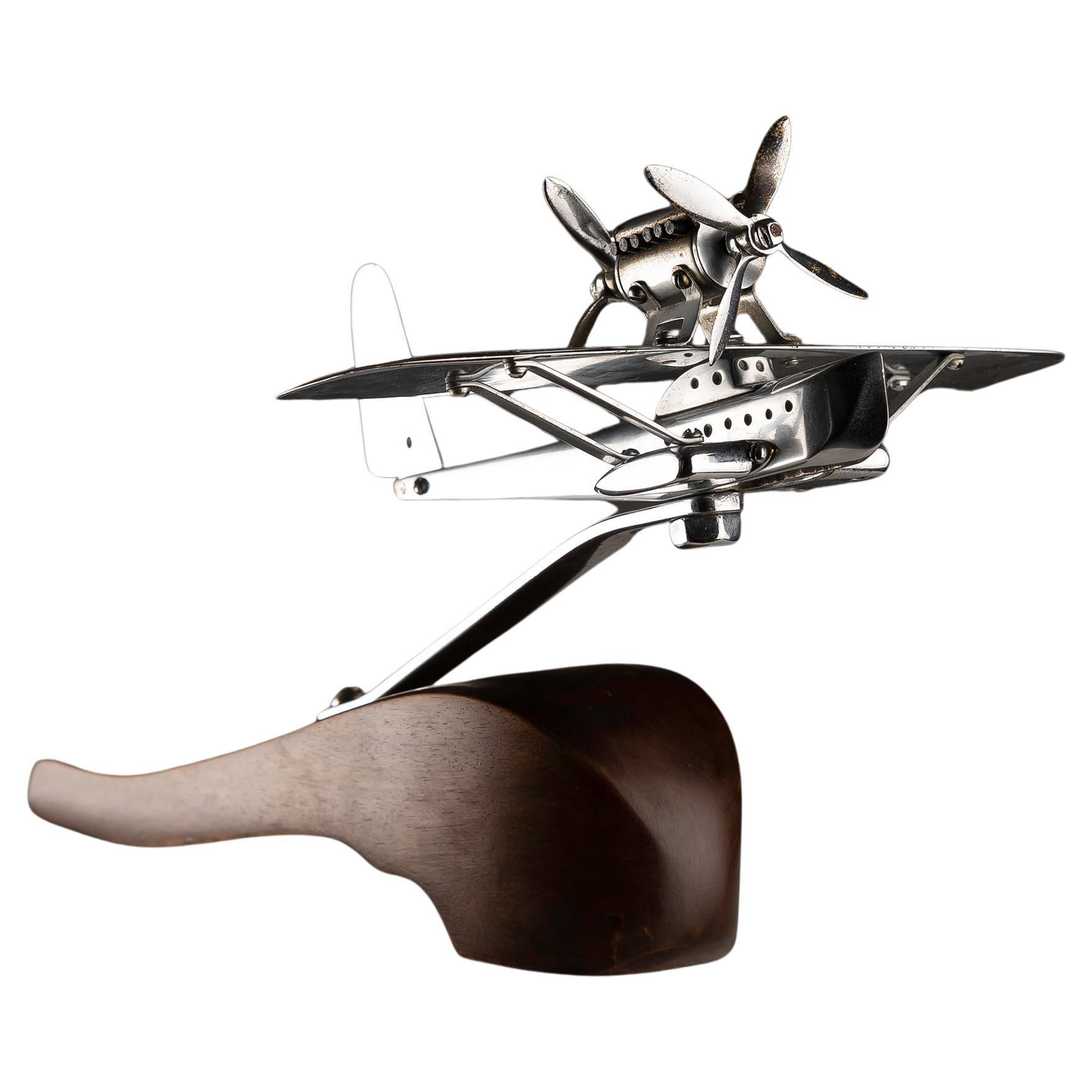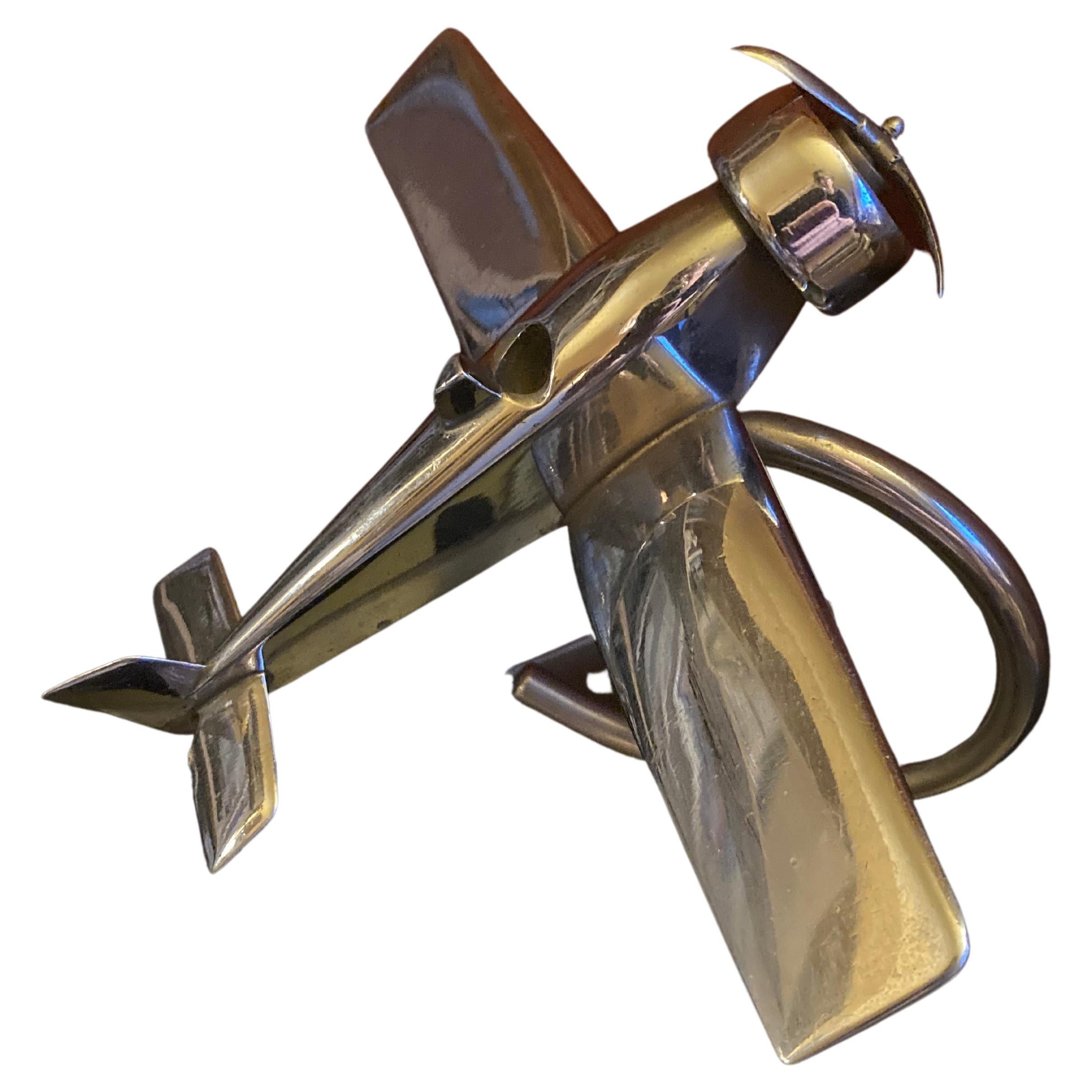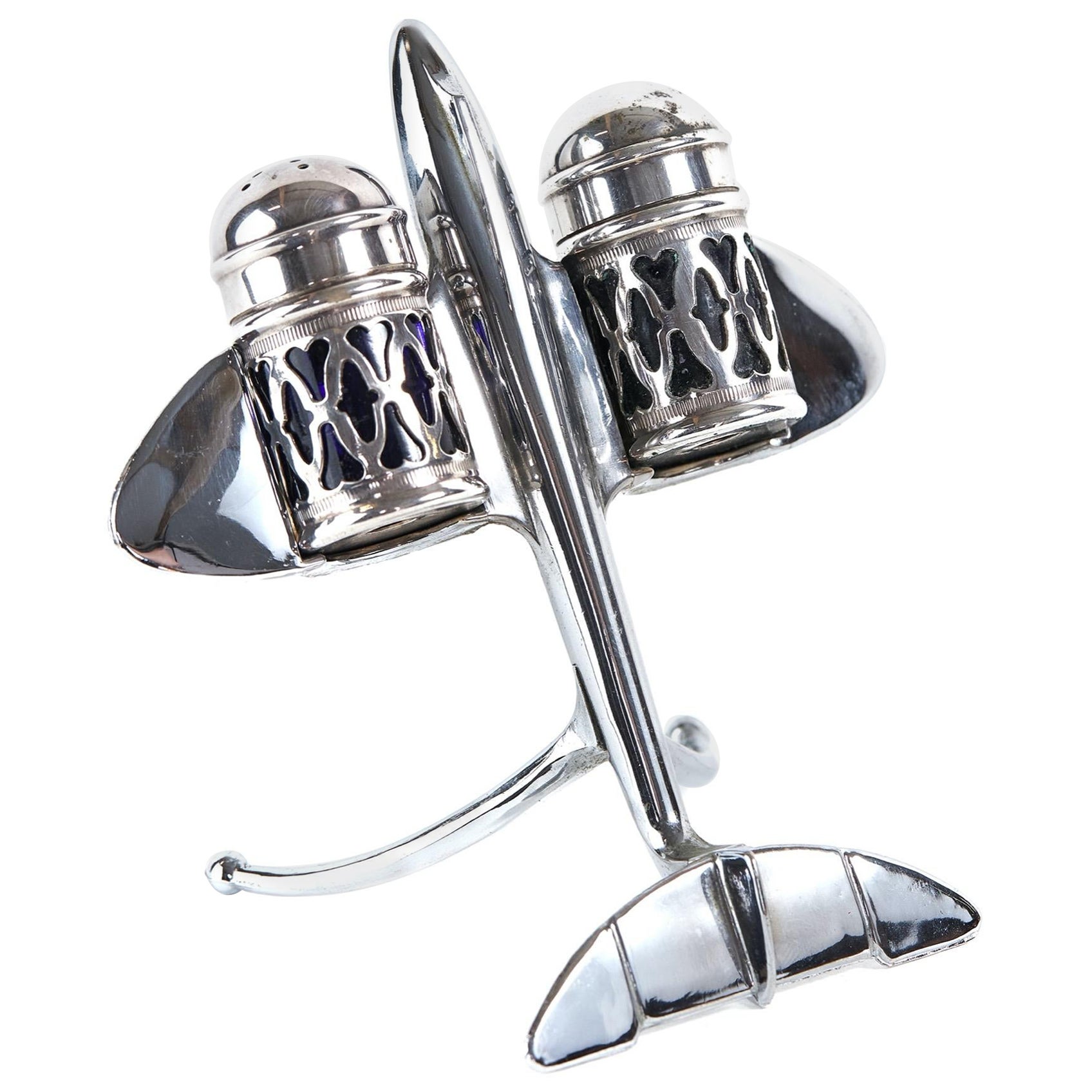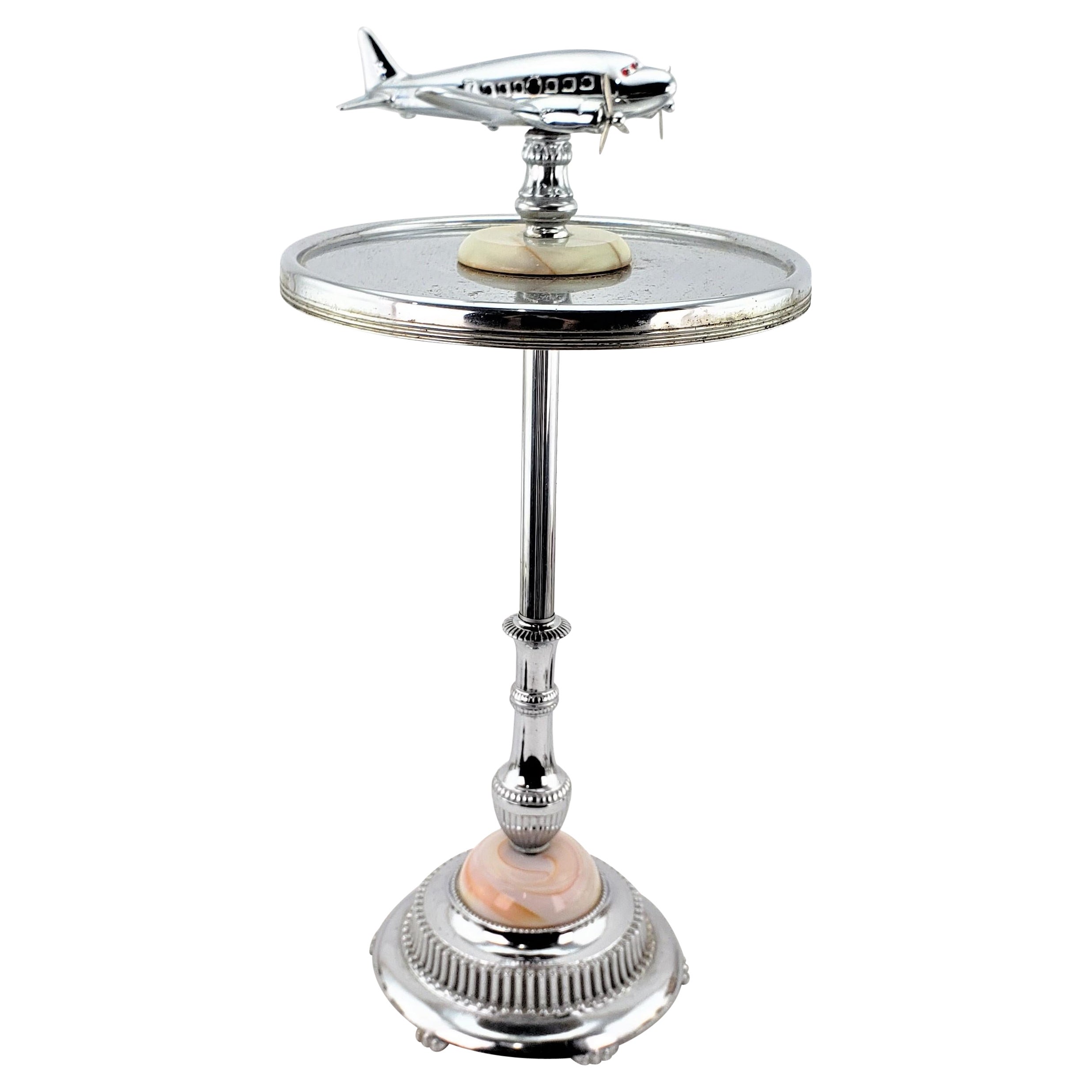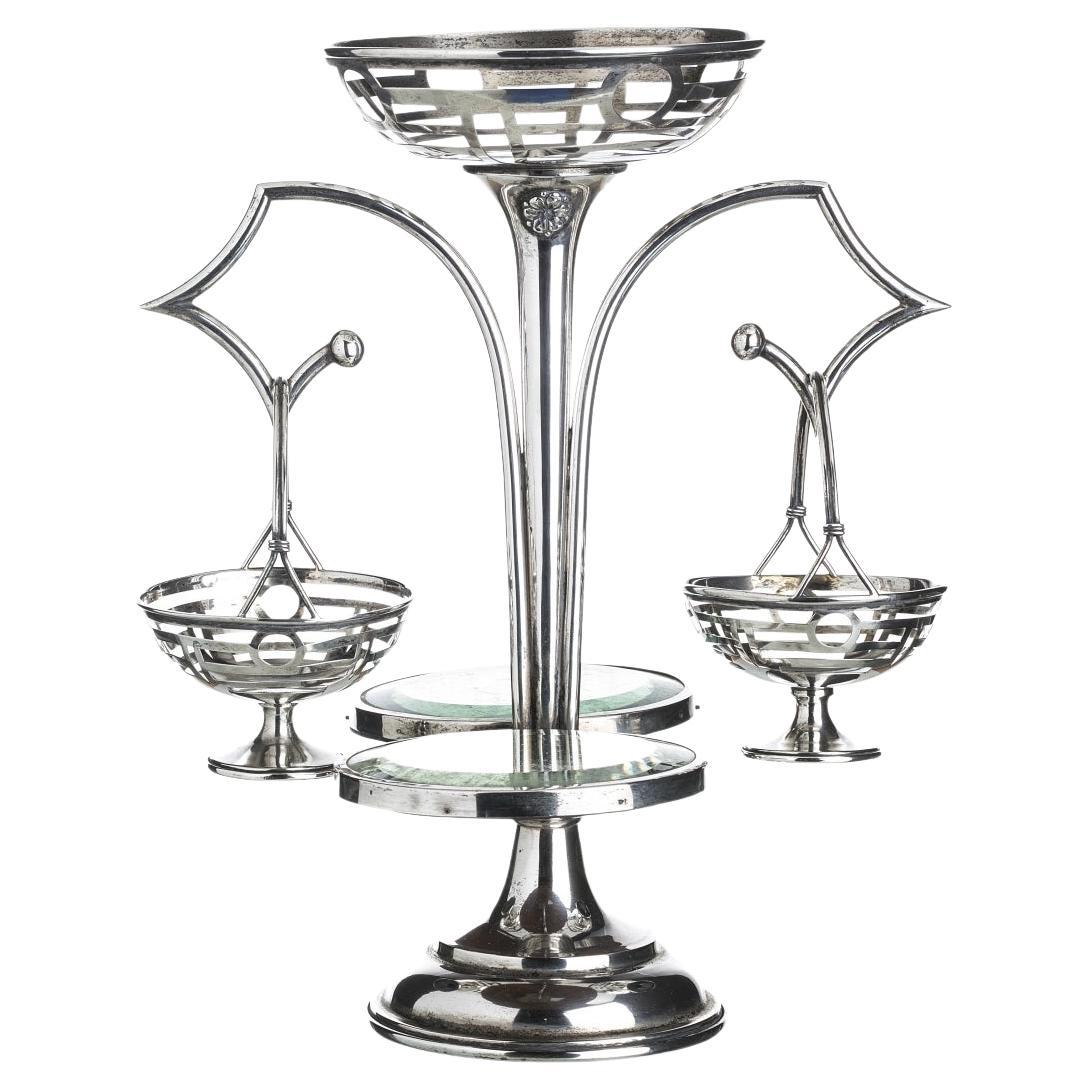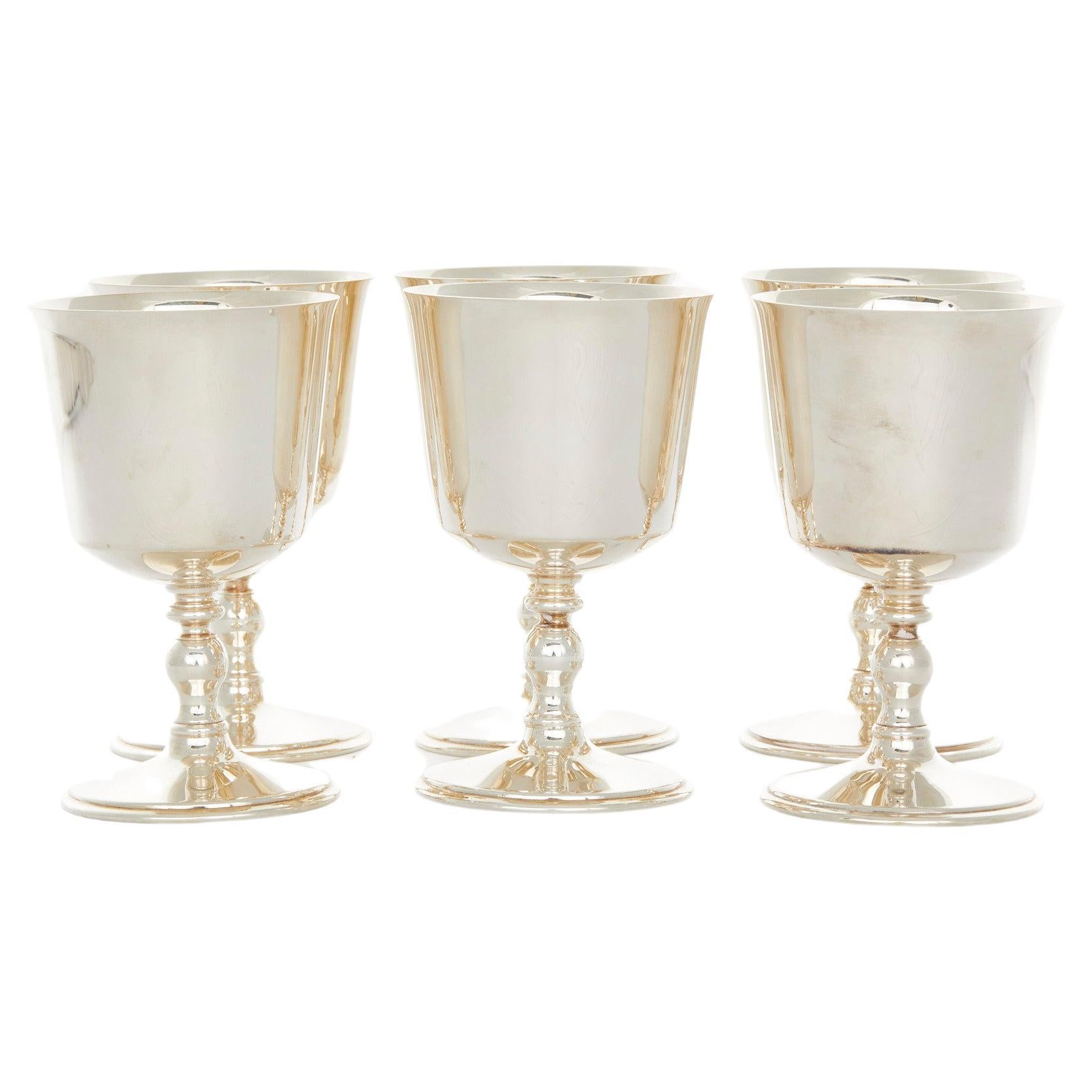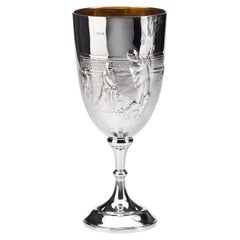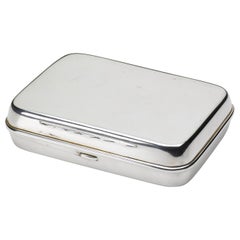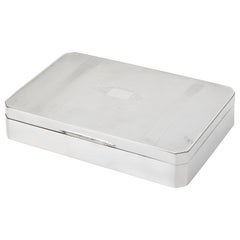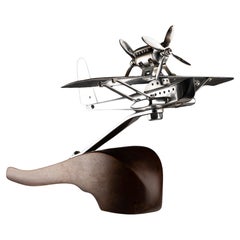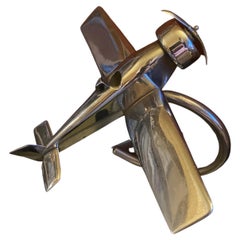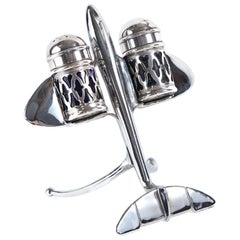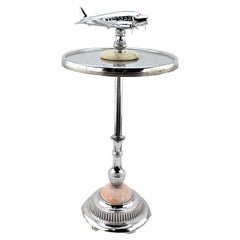Items Similar to Silver Plated Airplane-Themed Tableware, circa 1910
Want more images or videos?
Request additional images or videos from the seller
1 of 9
Silver Plated Airplane-Themed Tableware, circa 1910
$2,600
£1,963.69
€2,268.37
CA$3,663.03
A$3,923.11
CHF 2,109.03
MX$47,648.42
NOK 26,648.68
SEK 24,398.85
DKK 16,948.89
About the Item
This is a beautiful silver-plated egg cup and spoon set with an airplane motif, dating to the early 1910s. The set includes four matching footed egg cups. The cups sit upon the stacked wings of a biplane. Four small egg spoons accompany the set. The set was made by James Dixon & Son, 14 St. Andrews Street, Holborn Circus, London.
The 19th century saw an increased fascination with aviation, thanks in part to hot air ballooning and the invention of Zeppelin dirigibles. But flight as we know it today, in fixed-wing airplanes, began in the early 20th century, as entrepreneurs and engineers including William E. Boeing, Donald Douglas Sr., James H. "Dutch" Kindelberger, and James S. McDonnell began to build on what the Wright Brothers had started not so long before. This hunger and fascination for all things aviation found its way to popular design, from advertisements to clothing designs to table settings.
Herbert Johnson discusses this phenomena in his book Wingless Eagle: U.S. Army Aviation through World War I: “…Even men’s haberdashery was impressed with an aeronautical stamp. The November 1910 Collier’s offered for sale two styles of Silver Band collars: one that was 2 1/8 inches high was named the Biplane; the taller collar, 2 3/8 inches high, was denominated the Monoplane… An Adler-Rochester Clothes ad featured a male model posed at the open door of an airplane factory, presumably discussing flying with another well-dressed aeronaut…The most ingenious use of aviation motif was probably the advertisement of the International Correspondence Schools, America’s largest mail-order educational institution. Their 1913 advertisement depicted a flying airplane to which was appended the slogan, “Nothing Is Impossible to Men with Ambition”.
CONDITION:
This silver-plated egg and spoon set is in very good condition, and comes in its full set with no missing pieces. Wear is consistent with age and gentle use. No significant areas of tarnish. Hallmarked along back tail wing.
Dimensions: 4 1/4" H x 7 1/2" W x 8 1/2" D.
- Dimensions:Height: 4.5 in (11.43 cm)Width: 7.5 in (19.05 cm)Depth: 8.5 in (21.59 cm)
- Style:Art Deco (Of the Period)
- Materials and Techniques:Silver,Plated
- Place of Origin:
- Period:
- Date of Manufacture:1910
- Condition:Wear consistent with age and use.
- Seller Location:Colorado Springs, CO
- Reference Number:Seller: S0181stDibs: LU909730467352
About the Seller
4.9
Platinum Seller
Premium sellers with a 4.7+ rating and 24-hour response times
Established in 2010
1stDibs seller since 2011
473 sales on 1stDibs
Typical response time: 4 hours
- ShippingRetrieving quote...Shipping from: Colorado Springs, CO
- Return Policy
More From This Seller
View AllSilver Sheffield Cricket Sugar Jar, circa 1900
Located in Colorado Springs, CO
This is an exquisite early 20th century crystal jar with a silver lid and spoon. The lid's top is fashioned after a cricket wicket. The jar sits on a round silver base with decorativ...
Category
Antique Early 19th Century British Sheffield and Silverplate
Materials
Silver
Sterling Silver Cricket Trophy, circa 1923
Located in Colorado Springs, CO
This is a handsome sterling silver trophy dating to circa 1923. Detailed in raised relief on the the goblet-shaped trophy is an energetic cricket scene. It shows a cricket batter as ...
Category
Vintage 1920s British Sports Equipment and Memorabilia
Materials
Sterling Silver
Hallmarked Silver Plated Keepsake Box, Sheffield, Uk, Circa 1900
Located in Colorado Springs, CO
Offered is a stunning Sheffield silver keepsake box dating to 1900, with associated hallmark. This small box includes a clean interior and rounded corners. The box is free of names or initials, but would have been used to house keepsakes such as jewelry or cufflinks. A well maintained, elegant piece, this antique silver box is an excellent addition to any silver collection.
Trinket or keepsake boxes have taken on many forms since their first conception in ancient times. However their purpose remains the same; to store jewelry and other items precious to the owner. Originally, these boxes were used specifically for jewelry. These were in common use as early as 5000 BC in Ancient Egypt, when the majority of Egyptians, both male and female, wore jewelry. Boxes were used to keep these gemstone encrusted items safe. In Ancient Rome, jewelry was a status symbol. Rings and brooches were utilized to represent ones status in society. Again, boxes were needed for security and storage purposes. Finding early examples of these are quite rare.
Victorian and Edwardian examples of trinket boxes are far more common. This is because owning jewellery was a luxury until the Victorian era- let alone possessing so much a box was needed to store it all. Fine jewelry and other items became available to the masses after the industrial revolution due to the reduction in production costs. This led to a demand for trinket boxes, which were much smaller than jewelry boxes and therefore better suited to the needs of the middle class who did not yet possess an abundance of jewelry.
In Victorian households, collectables and other items of interested were also stashed inside these boxes. This is why they are known as trinket or keepsake boxes, rather than just jewelry boxes, although of course jewelry was also stored in them. Trinket boxes were produced in large numbers around this time. Many were lined with colored plush or velvet or rich wood. More elaborate designs had interior divisions and trays for rings and other pieces of jewellery. It was also common to see trinket boxes so small that they could only contain one item, such as a single ring. Ornate exteriors were created to reflect the value of the trinket boxes contents.
The Edwardian era saw the introduction of new styles of trinket box. These included small circular or oblong boxes...
Category
Antique Early 1900s British Art Deco Decorative Boxes
Materials
Silver
Hallmarked Silver Plated Keepsake Box, Sheffield, UK, circa 1900
Located in Colorado Springs, CO
Offered is a stunning silver plated keepsake box dating to 1900, with associated hallmark. This small box includes a wooden interior with two slots and a blank square on top where initials could have been engraved. A well maintained, elegant piece, this antique silver box is an excellent addition to any silver or home decor collection.
Trinket or keepsake boxes have taken on many forms since their first conception in ancient times. However their purpose remains the same; to store jewelry and other items precious to the owner. Originally, these boxes were used specifically for jewelry. These were in common use as early as 5000 BC in Ancient Egypt, when the majority of Egyptians, both male and female, wore jewelry. Boxes were used to keep these gemstone encrusted items safe. In Ancient Rome, jewelry was a status symbol. Rings and brooches were utilized to represent ones status in society. Again, boxes were needed for security and storage purposes. Finding early examples of these are quite rare.
Victorian and Edwardian examples of trinket boxes are far more common. This is because owning jewellery was a luxury until the Victorian era- let alone possessing so much a box was needed to store it all. Fine jewelry and other items became available to the masses after the industrial revolution due to the reduction in production costs. This led to a demand for trinket boxes, which were much smaller than jewelry boxes and therefore better suited to the needs of the middle class who did not yet possess an abundance of jewelry.
In Victorian households, collectables and other items of interested were also stashed inside these boxes. This is why they are known as trinket or keepsake boxes, rather than just jewelry boxes, although of course jewelry was also stored in them. Trinket boxes were produced in large numbers around this time. Many were lined with colored plush or velvet or rich wood. More elaborate designs had interior divisions and trays for rings and other pieces of jewellery. It was also common to see trinket boxes so small that they could only contain one item, such as a single ring. Ornate exteriors were created to reflect the value of the trinket boxes contents.
The Edwardian era saw the introduction of new styles of trinket box. These included small circular or oblong boxes...
Category
Antique Early 1900s English Art Deco Decorative Boxes
Materials
Silver
$600 Sale Price
20% Off
Silver Plated Keepsake Box, Early 20th Century
Located in Colorado Springs, CO
Offered is a silver plated keepsake box, dating to the early 1900s. The hallmarked box offers great storage solution for jewelry, cufflinks, and other keepsakes, with a divided inter...
Category
Antique Early 1900s English Jewelry Boxes
Materials
Silver
Vintage Cast-Iron Eagle Sculpture, Early 20th Century
Located in Colorado Springs, CO
This is a cast-iron figural eagle doorstop, circa early 20th century. The eagle is depicted with wings spread wide, perched and mounted to a square marble base. The eagle retains traces of its original gilt surface and is embossed with “F.O.E.” at its midsection, possibly referring to the Fraternal Order of Eagles.
The eagle is both the national bird and the national animal of the United States. The eagle motif has been widely used throughout American history, most notably as part of our Great Seal. The founders of the United States were fond of comparing their new republic with the Roman Republic, in which eagle imagery, usually the golden eagle, was prominent. On June 20, 1782, the Continental Congress adopted the design for the Great Seal of the United States...
Category
Early 20th Century American Federal Animal Sculptures
Materials
Marble, Iron
You May Also Like
Art Deco Chrome Airplane Sculpture on Wooden Base, 1940s
Located in BARCELONA, ES
This striking Art Deco airplane sculpture captures the fascination with aviation that marked the early 20th century. Designed in the 1940s, the piece combines the streamlined dynamis...
Category
Vintage 1940s French Art Deco Mobiles and Kinetic Sculptures
Materials
Chrome
Art Deco Chrome Aeroplane from the 30s, Decorative Desk Object
Located in Köln, NW
Decorative Art Deco chrome airplane on plastic base. Desk decoration. Probably Germany or France of the thirties. The plastic plate is also from the time. Good general condition with...
Category
Vintage 1930s Unknown Art Deco Abstract Sculptures
Materials
Metal, Chrome
Vintage Chrome Jet plane Cruet set 1950s
By FROM Industrial Design
Located in Dereham, GB
Vintage Chrome Jet plane Cruet set
circa 1950
Chrome plated body ,
the wings shaped to hold Salt & Pepper pot , in form of the Jet engines,
pots wi...
Category
Vintage 1950s British Streamlined Moderne Tableware
Materials
Chrome
$247 Sale Price
20% Off
Art Deco Styled Chrome Lighted Airplane Smoker's Ashtray Stand or Accent Table
Located in Hamilton, Ontario
This very unique lighted smoker's stand is unsigned, but presumed to have been made in North America, likely the United States, in approximately 1950 in an Art Deco style. This smoke...
Category
Mid-20th Century American Art Deco Tobacco Accessories
Materials
Metal
Art Deco Silver Table Center 20th Century
Located in Madrid, ES
ART DECO SILVER TABLE CENTER
In silver with relief and pierced decoration with central body with two removable baskets and two bases with mirror...
Category
Early 20th Century Portuguese Art Deco Desk Sets
Materials
Silver
English Silver Plated Art Deco Barware Service
By Mappin & Webb
Located in Tarry Town, NY
English silver plated Art Deco style barware / tableware drinking goblet service for six people. Each silver cup is in great condition. Minor wear. Maker...
Category
Vintage 1930s English Art Deco Barware
Materials
Silver Plate, Copper
$1,800 / set
More Ways To Browse
Dutch Antiques
7 Foot Long Dining Tables
Antique Egg Spoons
Silver Egg Cup And Spoon
Antique Zeppelin
Airplane Wing
Antique Silver Egg Cup Set
Heath Ceramics Plate
Sheffield Silver Fork
Sheffield Silver Plated Cup
Silver Plated Cruet Set
Antique Food Warmers
Antique Hot Plate
Antique Silver Plated Coffee Pot
Silver Plated Cake Stand
Victorian Antique Silver Biscuit Box
Antique Rogers Silver
Cruet Bottles Antique
